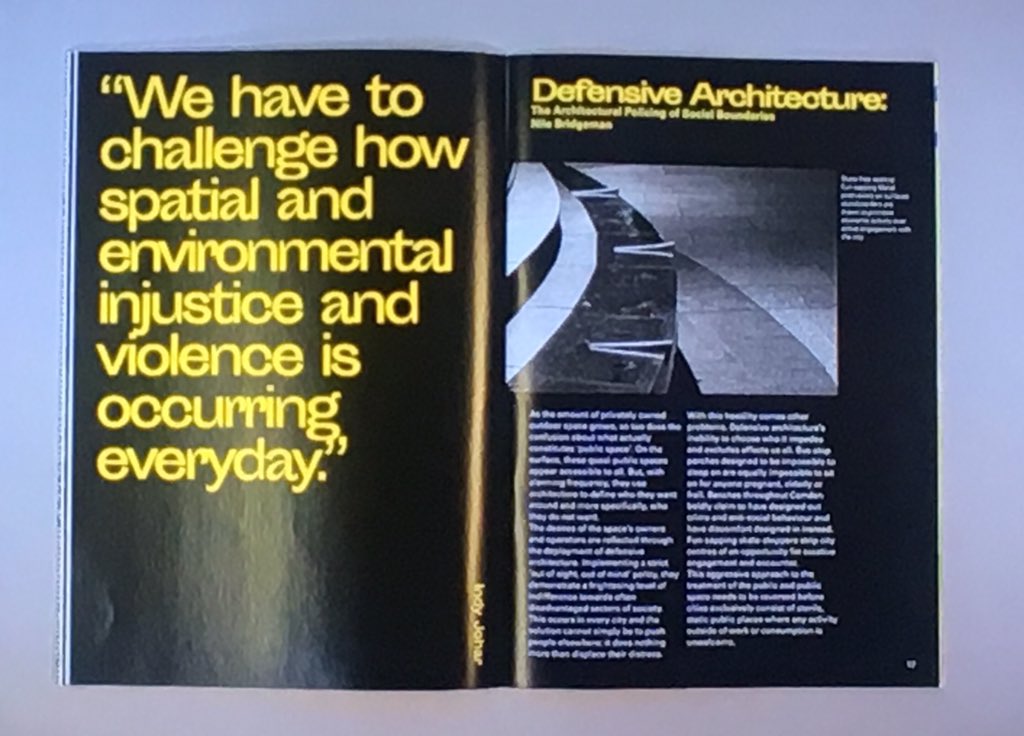Post
REPORT | Public Spaces for Diverse Places
24 Feb 2020
In this talk chaired by Holly Lewis from We Made That, Nile Bridgeman and Akil Scafe-Smith discussed their work since Afterparti Issue 00 was published last year. Brian Whitely provides the first of our reports on the evening's discussion at Kohn Pederson Fox's offices in Covent Garden.
Nile Bridgeman is from Afterparti, an architectural collective. He outlined how research by his group made them want to challenge injustices which arise every day in public spaces – both publicly owned and privately owned (“quasi public”) spaces. He suggested two measures for assessing how spaces work:
- Spatial equity – who has a say in shaping places
- Spatial value – who defines a space
Often “defensive architecture” designed to exclude some misuse of spaces in effect excludes everyone to a lesser or greater extent from using them. A prime example he showed was the “Camden bench”, which is becoming widely used for seating in public spaces, yet is deliberately shaped to make sitting for any length of time uncomfortable by causing muscle pain. This design approach is one which seems to see more use of a space meaning more potential misuse – perhaps through over prescriptive use of crime prevention design. Similarly, spikes are used on ground floor commercial building window sills to discourage their impromptu use for seating; and some public spaces now feature circular seating - introduced to discourage groups of several people sitting together and being able to face each other (e.g. see George Yard in the City)
He suggested spaces often work better when they are less designed, and simply surrounded by active commercial uses e.g.:
- the piazza at Covent Garden might be seen as one example, with little additional street furniture felt necessary for it to work successfully;
- the public areas by the river at the South Bank centre might be seen as another – the latter catering for specific groups such as with the retention of the skate board undercroft for local young people;
- Kensington High Street seems to have attracted back greater footfall now the former street clutter has been removed and a pedestrian-friendly central island introduced which also incorporates stretches of cycle parking – see here:
- Hackney’s Broadway Market, which amongst other measures has introduced dropped kerbs to ease movement for pedestrians.
Akil Scafe-Smith is from Resolve, a multi-disciplinary design collective, which has concentrated on workshops and installations to date, such as the Brixton Design Pavillion in 2016. It used local materials – e.g. from the local market - to form a temporary pavilion for exhibitions, discussions and other events and partly aimed to attract young people with their intricate knowledge of the local area in order to gauge their ideas on possible improvements to local public spaces.
They have since held similar projects around the country, e.g.:
- An emotional mapping project and related events in the Manor Park area of Sheffield
- Investigating and then using Afro-Caribbean designs for an updating of the Brixton Railway Bridge.
- Workshops held as part of a legacy event following the City of Culture year in Hull, which explored young people’s views on how the city centre could be shaped to meet their needs and interests.
The collective have also explored how cultural roots of the different local Afro-Caribbean communities in Brixton could help influence future urban design in the area. The market there makes use of a variety of materials related to the Caribbean diaspora (e.g. with the historical development of the banana industry post-1945) which he suggested could be used to guide future cultural signposting for urban spaces and thereby gain recognition and use by local people.
A short question and answer session followed. Points raised included:
- How to make people freely access public spaces which might be contested for use?
- User groups often have physical, social, economic or other impediments to making full use of spaces and / or how they are able to use them.
- It is difficult in areas of transient population churn to encourage mutual recognition and value of using particular public spaces.
- Over-design of public spaces can be difficult to avoid, and they need to be able to allow changes over time in their nature and use.
